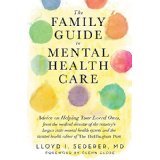
Lloyd I. Sederer, MD
When celebrities take their lives that makes the news. Some page one people have included Robin Williams (age 63), Kurt Cobain (27), Junior Seau (43), Marilyn Monroe (36), Vincent Van Gogh (37), Hunter Thompson (67), Sylvia Plath (30), Virginia Woolf (59), Ernest Hemingway (61), and others we have known and admired. Their loss is public, and often hard to comprehend.
But what the celebrity list does not include are the over 42,000 people who die from suicide, that we know of, annually in this country. That exceeds deaths from breast cancer, motor vehicle accidents and is double the number of homicides in the US. Do you know someone who died from suicide, perhaps someone close to you?
Suicide is among the 10 most common preventable causes of death, and the only one that has increased over the past 10 years, where the rate has increased by over 20 percent.
I recall some years ago, as a psychiatrist and public health doctor, the approach I took to trying to save a person from taking their own life. Since 90 percent of people who die by their own hands have an active mental disorder, including major depression, alcohol or drug dependence, PTSD, and bipolar illness, my approach was to detect, diagnose and treat the illness and thereby prevent suicide. But we know more today that allows for a different and more immediate approach.
We need to think about suicidal thinking and intent as a “co-morbid” condition to the mental disorder. Co-morbid is a medical term which means it co-exists with another condition and produces serious problems of its own. Suicidality is a co-morbid condition, can be deadly, and requires its own detection, diagnosis and intervention.
And doctors, nurses and other health professionals have unique and frequent contact with people who are struggling to resist the unbearable pain of mental illness and the hopelessness that mental conditions typically induce. We know that 45 percent of people who died by suicide were in the primary care doctor’s office in the month before their death; that number is nearly 80% for older adults. 1 in 5 people who took their lives were in the office of a mental health professional in the month anteceding their demise. What this means is that every one of these encounters is an opportunity to detect this problem and save lives.
But health care has yet to adopt the practice of preventing suicide. Virtually no primary care clinicians are trained or employ methods to prevent suicide. Even the predominance of mental health professionals acknowledge limited training and comfort asking about suicidality and knowing what to do. For people admitted to psychiatric wards in hospitals, which is primarily for active suicidality, they receive no specific intervention for suicidality. Can you think of any other case where the very condition that leads to a hospital admission goes almost universally untreated?
Earlier this week, the New York State mental health agency put on a 2 day conference called “1700 Too Many”, referring to the number of people who died by suicide in this state in the last year data is available. This month is National Suicide Prevention month is this country. (Disclosure, I work for this agency and the conference was organized out of my office, but led by Drs. Jay Carruthers and Sigrid Pechenik, not by me).
While many things were discussed by experts and clinicians I want to highlight one critical intervention that has emerged in recent years that can and does save lives. Clinicians today principally need to learn to do three things for those at risk:
1. Establish a “Safety Plan”, a preplanned way to get support and reduce the impulse to act (click here for an educational video on Safety Plans). There is a phone App where individuals affected can load their own personal safety plan, and turn to it immediately if needed.
2. Maintain phone or in person contact (called a “Warm Handoff”) in the days following a suicide attempt, an emergency room visit, or a psychiatric or addiction hospital stay.
3. Reduce access to deadly means of self-destruction, especially guns. This does not mean confiscating guns but rather securing them with gun locks or having a family member or friend hold them until safety recurs. 90% of suicide attempts with a firearm are fatal, and half of suicides in recent years have been by firearm.
Numbers 2 & 3 are relatively self-explanatory. Let me say a bit about Suicide Safety Planning, which can take 30-40 minutes of a clinician’s (and patient’s time). Because suicide risk fluctuates over days, even hours, a person in danger will benefit from developing a plan for safety before the deadly moment arises, especially because problem solving capabilities diminish during a crisis.
A safety plan specifically helps a person:
- Establish internal coping strategies, such as watching TV, listening to music, going for a walk, deep breathing or playing with a pet
- To seek the company of others, not to speak about their feelings but to not be alone
- To turn to family or friends for support if these first strategies don’t suffice
- To turn to a mental health professional if family or friends are not sufficient to provide safety
- And to reduce access to lethal means of suicide, like firearms
National and state strategies are underway to reduce suicides, to spare tens of thousands of people a preventable death. Of course, when a person dies from suicide about 10 others, family, friends, co-workers included, are also tragically impacted. It has been said that suicide is hardest on the survivors.
These prevention strategies include health and mental health settings but also extend to schools, the military, workplace settings and faith based communities. We have learned so much about how to save lives lost to suicide. Now is the time to turn that knowledge into everyday practice.
___________________________________________________________
The opinions expressed herein are solely my own as a psychiatrist and public health advocate. I receive no support from any pharmaceutical or device company.
*My new book, Improving Mental Health: Four Secrets in Plain Sight, Foreword by Patrick Kennedy, will be available this November, 2016
My book for families who have a member with a mental illness is The Family Guide to Mental Health Care (Foreword by Glenn Close) — is now available in paperback.
My website is http://www.askdrlloyd.com
Follow me on Twitter: @askdrlloyd


If you or someone you know needs help, call 1-800-273-8255 for the National Suicide Prevention Lifeline. Outside of the U.S., please visit the International Association for Suicide Prevention for a database of resources.